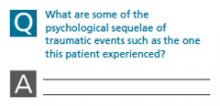JD had bilateral peripheral vision loss of both the medial and lateral visual fields with macular sparing bilaterally. But he had an otherwise normal physical examination. At this point, the neurologist suspected conversion disorder, while one ophthalmologist thought a neuropathic disorder was responsible.
The neurologist had, early on, recognized that JD was significantly distressed by the accident and encouraged a psychological consultation. With the absence of identifiable ophthalmologic pathology, the patient reluctantly accepted this referral.
The psychologist, aided by family medicine residents, entertained the diagnoses of Post-Traumatic Stress Disorder (PTSD) and somatoform disorders, particularly conversion. PTSD is unique among psychiatric diagnoses in that a patient must meet all 6 DSM V criteria:10
• exposure to a traumatic event involving actual or threatened death or serious injury
• recollections, dreams, or hallucinations in which the trauma is re-experienced
• avoidance of stimuli associated with the trauma
• persistent symptoms of increased arousal (eg, irritability, agitation)
• symptoms and behavior that last for longer than one month
• distress that is clinically significant.
He met the criteria for a PTSD diagnosis and likely would benefit from treatment for it. However, sensory loss related to PTSD alone would be unusual, perhaps as unusual as peripheral vision loss secondary to ammonia exposure. Other factors needed to be explored.
Conversion disorders consist of disorders of movement, such as seizures or paralysis, or disorders of sensations, such as numbness or blindness. These may be episodic or sustained and have acute or chronic onset.11
Psychological factors are judged to be associated with the symptom or deficit because conflicts or other stressors precede the initiation or exacerbation of the symptom or deficit. This was possible in JD, but a degree of uncertainty lingered because he did not exhibit behavior typically seen with factitious disorder, and performance anxiety could conceivably account for the outcome on his vision tests.
In general, he could meet the criteria for conversion disorder, but questions remained. The biggest question is whether the accident resulting in PTSD is the cause of the psychological stress, or is the peripheral vision loss the source of the psychological stress, which would mean it is not a conversion disorder?
Treatment of visual defects
As is the case in many disorders, a definitive diagnosis of the cause of vision loss is not necessary to begin treatment. When you suspect a somatoform disorder including conversion, start therapy and treat the symptoms as “real.”12 Tell the patient that no specific treatment will completely resolve the symptoms, but that it can help.13 Whether the primary cause is neurologic or conversion based, there is often some spontaneous recovery of vision that occurs between 2 weeks and 3 or more months.14 Peripheral field defects have a guarded prognosis, although an extensive rehabilitation program may improve the vision fields somewhat.15-18
Conversion disorders effectively respond to cognitive behavioral therapy (CBT) including gradual exposure to anxiety triggers.19 Rehabilitation for neurologic damage based on remodeling of pathways responds to a similar gradual exercise or exposure to the lost function. Since these interventions are similar processes, a definitive diagnosis was unnecessary in JD’s case. A proprietary visual rehabilitation therapy program is available17 that exposes the patient to visual field activity that requires a cognitive reaction.15 This treatment facilitates recovery even into the sixth month of therapy.16 However, the cost of the software is approximately $6000 and is not yet covered by insurance.15
JD could not afford the commercially available programmed therapy. Therefore, we introduced an alternative treatment plan to challenge the transitional zone. With this plan, JD would play video games for 30 minutes at least twice a week, and preferably daily. He sat close enough to the television so that the transitional zone was approximately 1 to 2 inches from the peripheral portion of the television screen. The game was an action-packed video in which the peripheral portion of the screen was important (such as in first-person shooter games). He was to continue staring at the center of the screen during play in order to truly exercise the peripheral vision. Every day, he reassessed where the transitional zone was located and adjusted his seating accordingly. JD practiced this at least once a day and found that he had to sit closer and closer to the television screen to allow the transitional zone to remain in the screen’s periphery.




